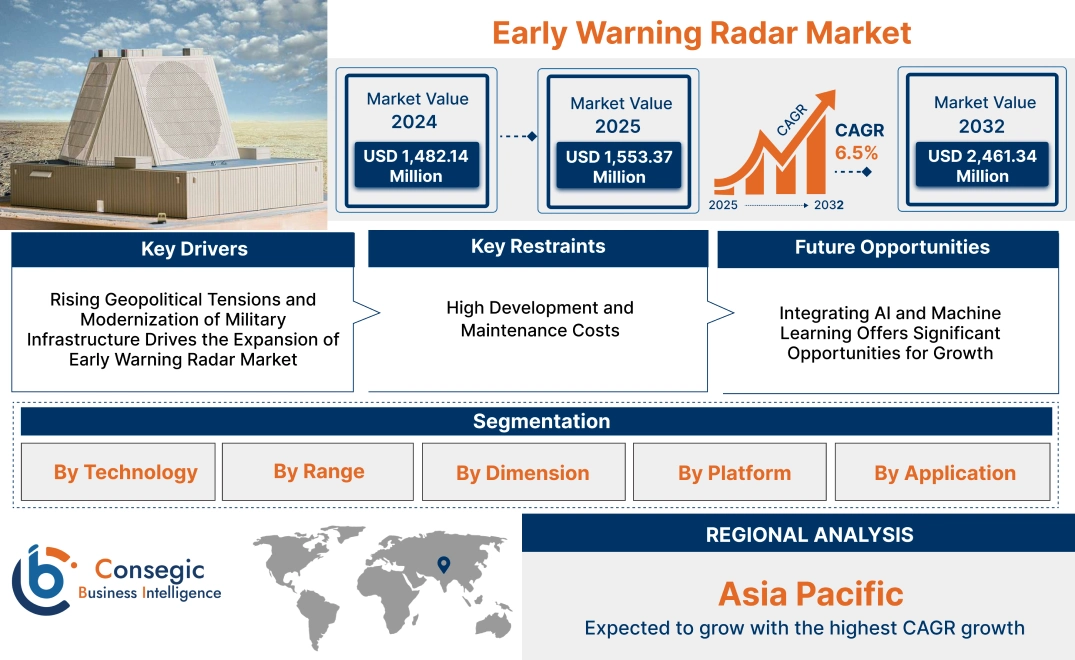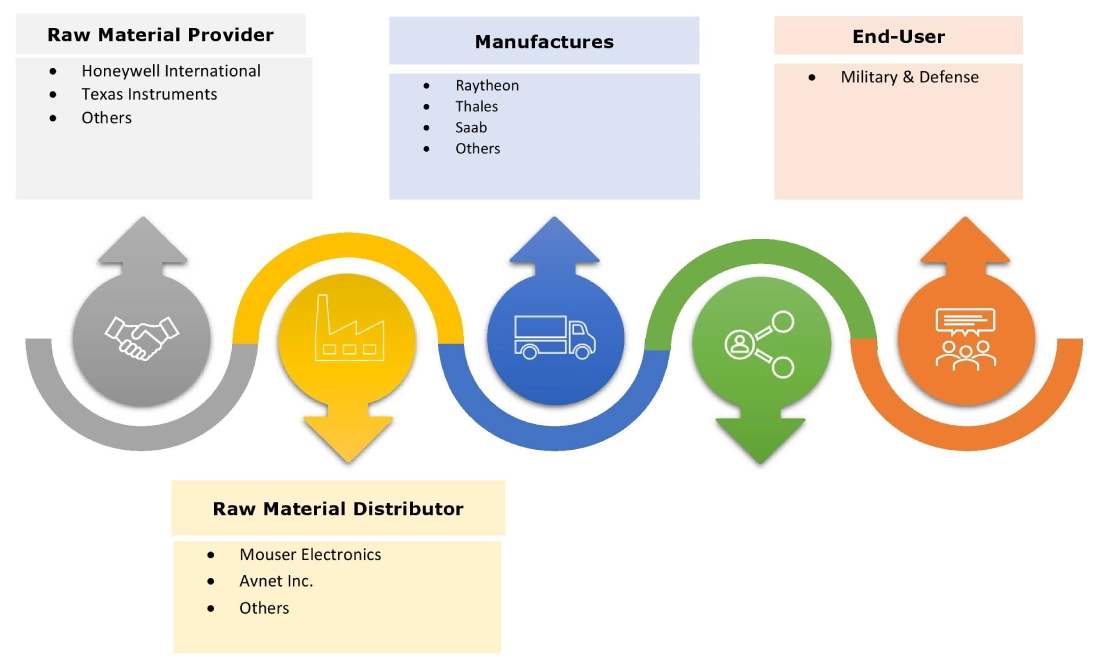Early Warning Radar Market Size:
Early Warning Radar Market Size is estimated to reach over USD 2,461.34 Million by 2032 from a value of USD 1,482.14 Million in 2024 and is projected to grow by USD 1,553.37 Million in 2025, growing at a CAGR of 6.5% from 2025 to 2032.
Early Warning Radar Market Scope & Overview:
Early warning radar is a specialized radar system designed to detect and track potential threats at long distances, providing crucial advance notice to enable timely defensive actions. The radars are optimized for detecting and tracking targets, such as aircraft, missiles, and ships, over very long distances. This early detection is vital for providing sufficient time to react to potential threats.
Early Warning Radar Market Dynamics - (DRO) :
Key Drivers:
Growing technological advancements are driving the early warning radar market expansion
Innovations in radar technology, such as phased array radar and advancements in signal processing, have substantially improved the accuracy, range, and reliability of early warning systems. The integration of artificial intelligence and machine learning algorithms into radar systems enhances their ability to detect and respond to modern threats. These technological advancements are crucial in addressing the evolving landscape of security threats, making them a key driver for market growth.
The rising geopolitical tensions and security threats across various regions are significant drivers for the global market. Nations are investing heavily in advanced radar systems to enhance their defense capabilities and ensure quick response times against potential threats, such as ballistic missiles, aircraft, and drones. This heightened focus on national security is driving demand for more sophisticated and reliable radar technologies.
- For instance, in May 2025, Thales announced the agreement with the Tawazun Council to establish the ground master air surveillance radar manufacturing facility in the UAE. A strategic partnership agreement between Tawazun Council and Thales is set to boost the UAE's sovereign and manufacturing capabilities. The production facility is anticipated to be fully functional by 2027.
Thus, according to the early warning radar market analysis, the growing technological advancements are driving the early warning radar market size.
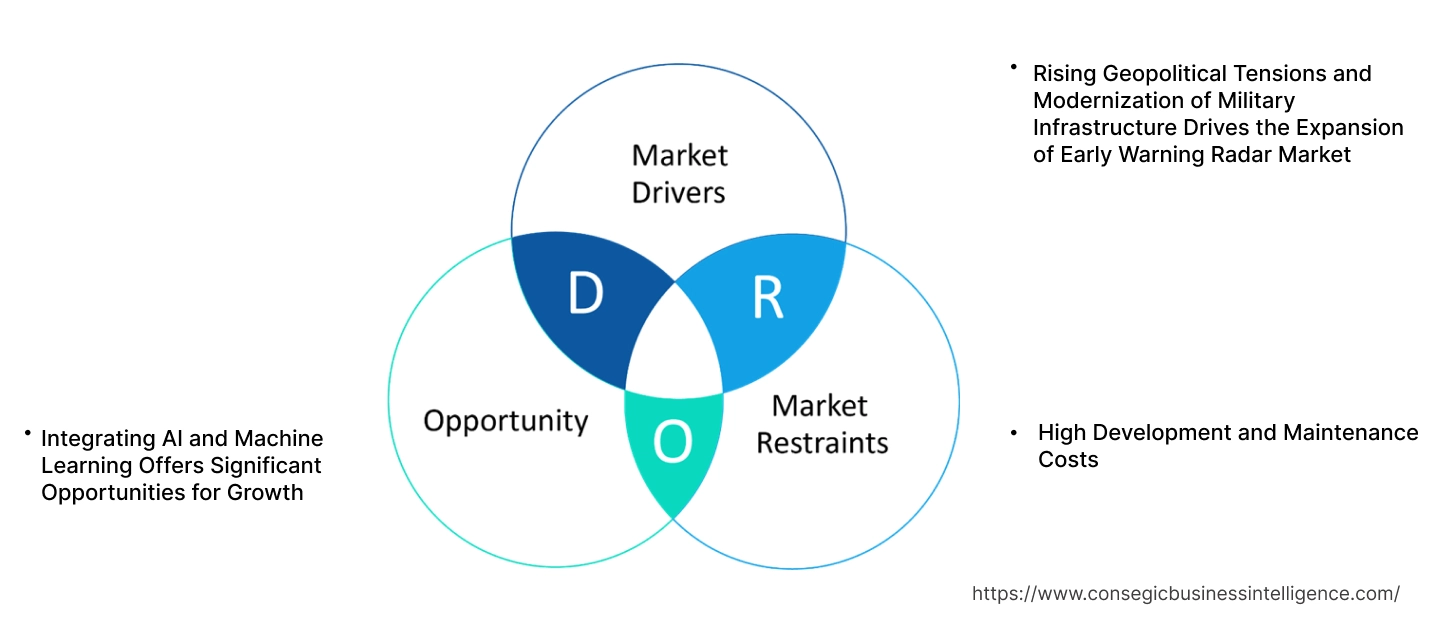 Key Restraints:
Key Restraints:
High development and maintenance costs are affecting the early warning radar market demand
The high costs associated with the research, development, and procurement of advanced radar systems create a significant barrier for many countries. These expenses include sophisticated sensors, complex signal processing, and seamless integration with existing defense infrastructure. Additionally, continuous maintenance costs such as inspections, component replacements, software updates, and the need for skilled personnel further strain defense budgets. This financial burden often forces nations to prioritize resource allocation while limiting the widespread adoption of radar technology. Thus, the aforementioned factors would further impact the early warning radar market size.
Future Opportunities :
Integrating artificial intelligence (AI) and machine learning into radar systems is expected to create potential growth for early warning radar market opportunities
Integrating AI and machine learning into radar systems can transform their capabilities. AI algorithms can analyze vast amounts of radar data in real time for faster, more accurate threat detection and classification. Machine learning models can adapt to new threats, enabling systems to anticipate and counter evolving enemy tactics. This enhanced intelligence improves situational awareness, reduces false alarms, and optimizes resource allocation. Additionally, AI-powered systems can automate routine tasks like target tracking, allowing human operators to focus on critical decision-making. Further, leveraging AI and machine learning makes early warning radar systems more efficient, effective, and adaptable to a dynamic threat landscape.
- For instance, in February 2025, Raytheon successfully conducted flight tests of radar warning receiver (RWR), a new AI-powered system, for fourth-generation jets. Raytheon incorporated the cognitive algorithm deployment system (CADS) into RWR systems, which enables real-time AI/ML processing at the sensor level. As a result, CADS can use better methods to effectively identify, sense, and prioritize threats.
Thus, based on the above early warning radar market analysis, the integration of artificial intelligence and machine learning into radar systems is expected to drive the early warning radar market opportunities.
Early Warning Radar Market Segmental Analysis :
By Technology:
Based on technology, the early warning radar market is segmented into pulse doppler radar, frequency modulated continuous wave (FMCW) radar, synthetic aperture radar (SAR), active electronically scanned array (AESA) radar, and others.
Trends in the technology:
- AI and machine learning (ML) are being increasingly adopted to improve radar performance across various functions like target detection, classification, and tracking.
- There's a growing emphasis on software-defined radar (SDR), which offers enhanced flexibility and adaptability in radar systems.
- Thus, based on the above analysis, these factors are driving the early warning radar market demand and trends.
The active electronically scanned array (AESA) radar segment accounted for the largest revenue share in the year 2024.
- AESA technology is expected to maintain its dominance in the coming years due to its significant advantages over traditional mechanically scanned arrays.
- A key factor driving this continued dominance is the integration of gallium nitride (GaN) technology into AESA systems. GaN offers superior performance characteristics, including higher power output, improved efficiency, and better thermal management.
- For instance, Northrop Grumman offers active electronically scanned array (AESA) radars in its product portfolio. These radars are used on fighter jets, bombers, and other aircraft to detect, track, and engage enemy aircraft and missiles.
- Thus, based on the above analysis, these factors are further driving the market.
The synthetic aperture radar (SAR) segment is anticipated to register the fastest CAGR during the forecast period.
- The increasing need for high-resolution imaging of the Earth's surface for applications such as military surveillance, environmental monitoring, and mapping is driving the synthetic aperture radar market.
- SAR is used in disaster management to assess the extent of damage caused by natural disasters such as earthquakes, floods, and landslides. Moreover, SAR is also used to detect and track objects on land and in water.
- For instance, in November 2022, Synspective announced the partnership with the Global Change Research System (GCRS) to provide SAR satellite-based risk analysis solutions in South Asia. This partnership will deliver crucial information to governments, NGOs, and the private sector. This will help them manage risks from natural disasters, climate change, and other environmental threats.
- Thus, the above factors are expected to drive the early warning radar market share during the forecast period.
By Range:
Based on the range, the early warning radar market is segmented into short range, medium range, and long range.
Trends in the range:
- The growing geopolitical tensions and conflicts are major key aspects driving the long-range and medium-range radar market.
- The continuous advancements in radar technology, such as AESA and GaN, are further driving the development of powerful radar systems.
The long range segment accounted for the largest revenue share of 45.56% in the year 2024.
- Long-range radar systems are essential for strategic defense applications, such as early warning and missile defense.
- These systems offer extended detection ranges, allowing early threat identification and response.
- The increasing focus on missile defense and the growing need for advanced early warning systems are driving the adoption of long-range radar systems.
- Technological advancements in radar technology, such as the development of over-the-horizon radar and high-frequency radar, are enhancing the capabilities of long-range radar systems, in turn driving the market.
- For instance, Thales offers Ground Master 400 Alpha in its product offerings, which can simultaneously detect and track a wide range of airborne threats, ranging from high-altitude fighter-bombers at distances exceeding 515 kilometers to low-flying tactical UAVs concealed within ground clutter. This versatility ensures comprehensive air surveillance and early warning against diverse aerial threats.
- Thus, based on the above analysis, these factors would further supplement the early warning radar market
The medium range segment is anticipated to register the fastest CAGR during the forecast period.
- Medium-range radars are crucial for enhancing border security and surveillance, enabling the detection and tracking of illegal activities and potential threats.
- Further, these systems play a vital role in maritime surveillance, including coastal defense, search and rescue operations, and maritime traffic monitoring, thereby driving the market.
- Hence, the aforementioned factors are anticipated to further drive the early warning radar market trends during the forecast period.
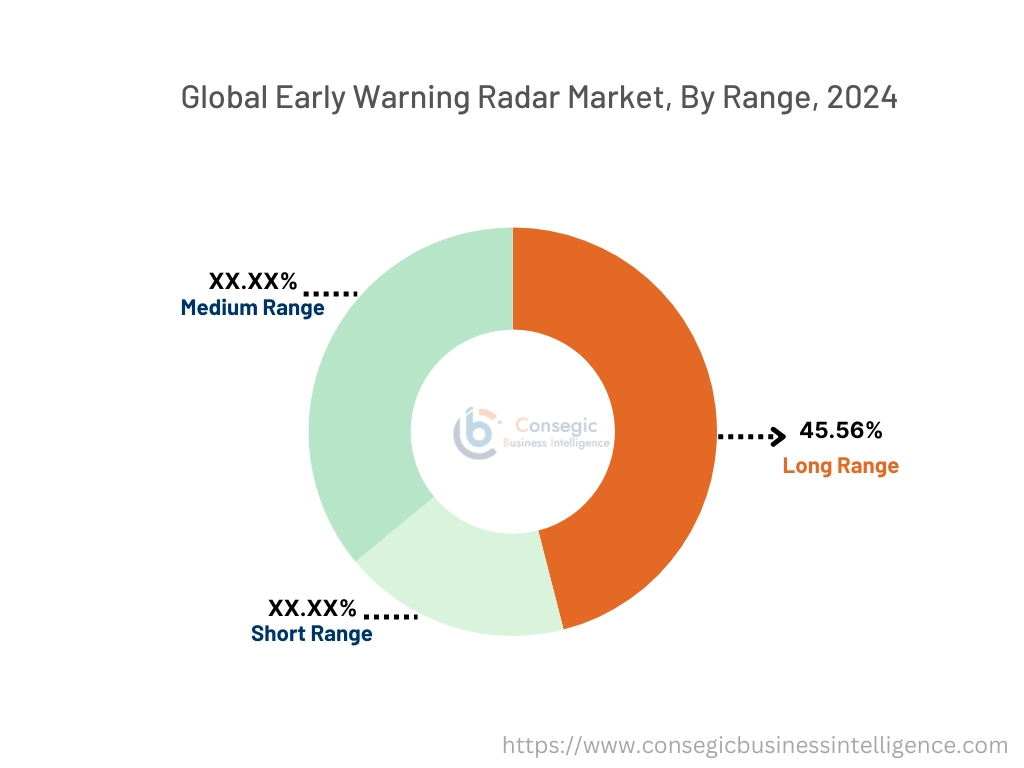
By Dimension:
Based on dimension, the market is segmented into 2D and 3D.
Trends in the dimension:
- The growing use of radars for maritime surveillance is boosting the need for both 2D and 3D radar systems, in turn driving the market.
- Increasing adoption of 3D radars for modern air and missile defense, due to their ability to detect and track threats across different altitudes.
The 2D segment accounted for the largest revenue share in the year 2024.
- The enhanced DSP (digital signal processing) capabilities improve target detection, clutter rejection, and overall signal quality, making 2D radars more effective in noisy environments.
- Moreover, several modern 2D radars are being optimized to detect small, low-flying targets, such as drones, which pose an increasing threat. This involves improved sensitivity and algorithms that are tailored to these specific threats.
- Thus, the aforementioned factors are driving the early warning radar market growth and trends.
The 3D segment is anticipated to register the fastest CAGR during the forecast period.
- 3D radars are increasingly integrated into broader defense networks, combining data with other sensors (satellites, electro-optical/infrared systems) to create a comprehensive multi-domain situational picture.
- The emergence of hypersonic weapons and the proliferation of ballistic missiles are driving the demand for 3D radars with exceptional detection and tracking capabilities at extreme ranges and high speeds.
- The advancements in technologies such as AESA and digital beamforming are enabling the development of more capable and cost-effective 3D radar systems.
- Hence, the above factors are anticipated to further drive the early warning radar market trends during the forecast period.
By Platform:
Based on the platform, the market is segmented into airborne radars, land-based radars, naval radars, and space-based radars.
Trends in the platform:
- The need for enhanced national air and missile defense against increasingly sophisticated threats is driving the growth of the segment.
- The increasing use of radars for border security & surveillance, and detecting & tracking illegal activities and potential threats is driving the global industry.
The land-based radars segment accounted for the largest revenue in the year 2024.
- Many nations are undertaking ambitious defense modernization programs that include upgrading or acquiring new ground-based radar systems.
- Land-based radars are witnessing increased adoption due to their widespread deployment for national defense, air and missile defense, and border security.
- The integration of ground-based radars with other sensors and command-and-control systems is significantly improving situational awareness and operational effectiveness.
- According to the analysis, the aforementioned factors are driving the early warning radar market growth and trends.
The space-based radars segment is anticipated to register the fastest CAGR during the forecast period.
- The developments in miniaturization and space technology are facilitating the creation of more capable and affordable space-based radar systems.
- These systems offer the significant advantage of global coverage, allowing surveillance of vast, inaccessible areas from ground or airborne platforms.
- For instance, in September 2024, Raytheon, an RTX business, delivered the initial sensor payload to Lockheed Martin for next-generation overhead persistent infrared (Next-Gen OPIR) Geosynchronous Earth Orbit (GEO) Block 0 missile warning satellite to the U.S. space administration.
- Hence, the above developments are anticipated to further drive the early warning radar market expansion during the forecast period.
By Application:
Based on application, the market is segmented into air and missile defense, surveillance and reconnaissance, collision avoidance, critical infrastructure protection, and others.
Trends in the application:
- Radar systems are increasingly used to provide early warning against threats to critical infrastructure, including unauthorized intrusions, drone activity, and other suspicious behaviors.
- The integration of radar systems with cybersecurity measures allows earlier detection of cyber threats and strengthens overall security.
The air and missile defense segment accounted for the largest revenue in the year 2024.
- There is a strong shift towards SDR, where much of the radar's functionality is moved from hardware to software. This provides immense flexibility and adaptability. Systems can be rapidly reconfigured or updated to address new threats, waveform types, or electronic warfare (EW) tactics.
- The growing threat from hypersonic weapons, drones, and long-range missiles is driving the early warning radar market.
- For instance, Thales offers a SMART-L radar system, which has a cutting-edge long-range 3D radar utilizing AESA technology. Further, with an exceptional range of 2000 km, it excels in detecting various targets, including stealth aircraft, ballistic missiles, and conventional aircraft. This versatile radar can be deployed on both land and sea platforms, providing crucial surveillance and target designation capabilities.
- Thus, the aforementioned factors are driving the global market.
The critical infrastructure protection segment is anticipated to register the fastest CAGR during the forecast period.
- Critical infrastructure protection is experiencing significant growth due to the increasing vulnerability of critical infrastructure to cyberattacks, physical threats, and natural disasters.
- Further, radar systems are used to establish and monitor perimeters around critical infrastructure, enhancing security and deterring unauthorized access.
- Manufacturers are developing modular radar systems that can be easily scaled to fit the size and complexity of different critical infrastructure sites, ranging from small substations to sprawling airports.
- Therefore, the above factors are anticipated to further drive the market during the forecast period.
Regional Analysis:
The global market has been classified by region into North America, Europe, Asia-Pacific, Middle East & Africa, and Latin America.
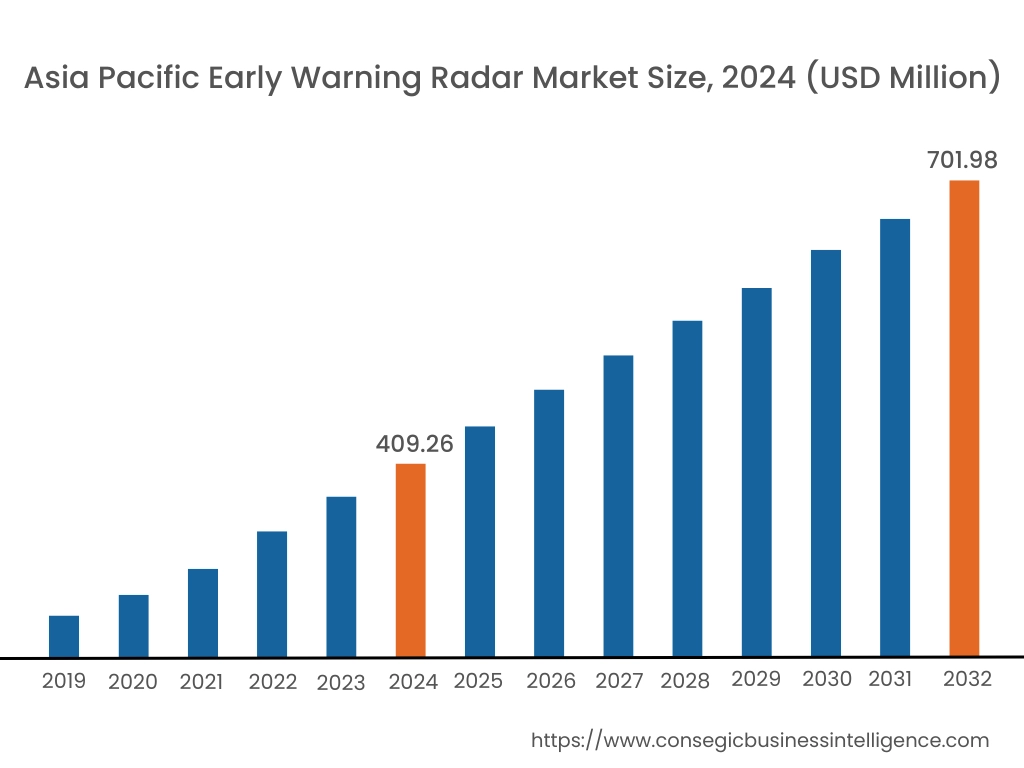
Asia Pacific region was valued at USD 409.26 Million in 2024. Moreover, it is projected to grow by USD 430.10 Million in 2025 and reach over USD 701.98 Million by 2032. Out of this, China accounted for the maximum revenue share of 29.9%. The region is expected to witness substantial growth in the global market, driven by rapid economic growth and increasing defense budgets in countries like China and India. Further, the growing focus on enhancing military capabilities and the increasing need for advanced defense systems are driving the demand for early warning radar systems in this region. Moreover, technological advancements and the increasing adoption of advanced radar systems by military forces in the region are expected to drive the regional early warning radar market during the forecast period.
- For instance, in January 2024, Japan provided the Philippines with an air surveillance radar system, enhancing the country's ability to monitor the South China Sea amid rising tensions with China. This delivery is part of a larger agreement to provide four radar systems aimed at strengthening the Philippines' defense capabilities.
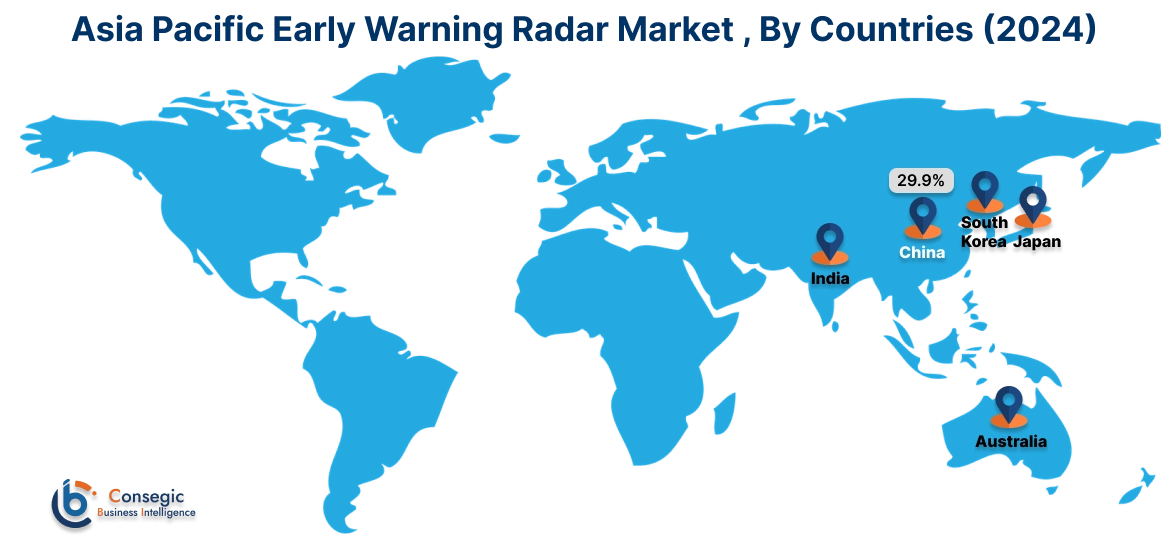
The North American market is estimated to reach over USD 767.94 million by 2032 from a value of USD 464.17 million in 2024 and is projected to grow by USD 486.33 million in 2025. The market in North America is driven by high defense expenditure and ongoing modernization programs. The United States is a significant contributor, with substantial investments in advanced radar technologies. The increasing focus on enhancing military capabilities and the growing need for advanced defense systems are driving the demand for early warning radar systems in this region. These factors would further drive the market in North America.
- For instance, in February 2024, the U.S. State Department approved a possible USD 1.2 billion sale of Airspace and Surface Radar Reconnaissance aerostat systems to Poland. These systems provide aerial surveillance and reconnaissance capabilities.
According to the analysis, the early warning radar industry in Europe is anticipated to witness significant development during the forecast period. Countries in the region are heavily investing in advanced radar systems to enhance their defense capabilities and ensure national security. The increasing focus on modernizing defense infrastructure and the growing need for advanced surveillance and reconnaissance systems are driving the need for early warning radar systems in Europe. The adoption of early warning radars in internal security, counter-narcotics operations, and disaster management is providing lucrative aspects for market development in the Latin American region. Further, the growing use of unmanned aerial vehicles (UAVs) in military and homeland security applications is driving the demand for compact and lightweight radar systems in the Middle East & Africa region.
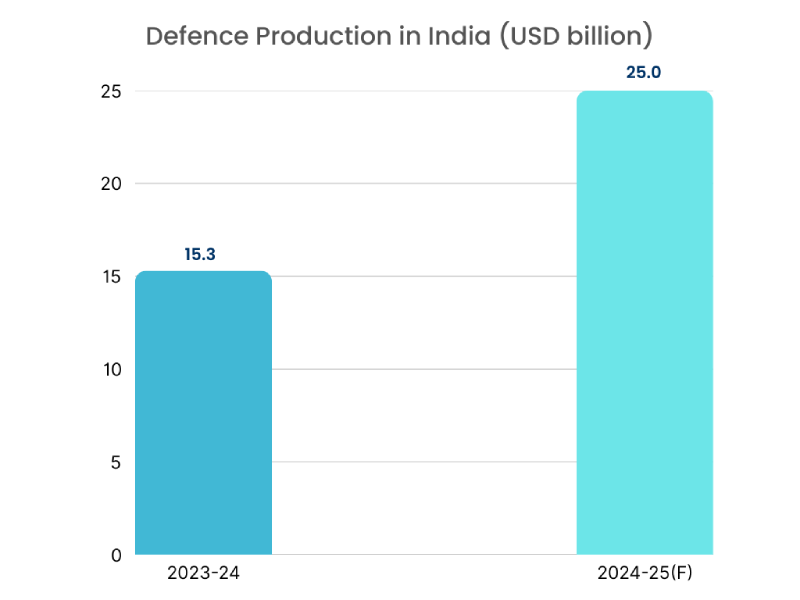
Top Key Players and Market Share Insights:
The global early warning radar market is highly competitive with major players providing solutions to the national and international markets. Key players are adopting several strategies in research and development (R&D), product innovation, and end-user launches to hold a strong position in the market. Key players in the early warning radar industry include-
- Raytheon (U.S.)
- Thales Group (France)
- BAE Systems (U.K.)
- Northrop Grumman (U.S.)
- General Dynamics (U.S.)
- Saab (Sweden)
- Leonardo (Italy)
- L3Harris Technologies (U.S.)
- Hensoldt (Germany)
- Lockheed Martin (U.S.)
Recent Industry Developments :
Contracts and Agreements:
- In February 2023, Saab secured a contract from the Polish Ministry of Defense for two Saab 340 Airborne Early Warning (AEW) aircraft. These aircraft, equipped with Saab's advanced Erieye radar, will enhance Poland's aerial surveillance capabilities. The contract, valued at approximately USD 57.37 million, includes ground equipment and comprehensive support services and will be fulfilled between 2023 and 2025.
Early Warning Radar Market Report Insights :
| Report Attributes | Report Details |
| Study Timeline | 2019-2032 |
| Market Size in 2032 | USD 2,461.34 Million |
| CAGR (2025-2032) | 6.5% |
| By Technology |
|
| By Range |
|
| By Dimension |
|
| By Platform |
|
| By Application |
|
| By Region |
|
| Key Players |
|
| North America | U.S. Canada Mexico |
| Europe | U.K. Germany France Spain Italy Russia Benelux Rest of Europe |
| APAC | China South Korea Japan India Australia ASEAN Rest of Asia-Pacific |
| Middle East and Africa | GCC Turkey South Africa Rest of MEA |
| LATAM | Brazil Argentina Chile Rest of LATAM |
| Report Coverage |
|
Key Questions Answered in the Report
How big is the Early Warning Radar Market? +
The Early Warning Radar Market is estimated to reach over USD 2,461.34 Million by 2032 from a value of USD 1,482.14 Million in 2024 and is projected to grow by USD 1,553.37 Million in 2025, growing at a CAGR of 6.5% from 2025 to 2032.
What specific segmentation details are covered in the Early Warning Radar report? +
The Early Warning Radar report includes specific segmentation details for technology, range, dimension, platform, application, and regions.
Which is the fastest segment anticipated to impact the market growth? +
In the Early Warning Radar Market, the 3D radar is the fastest-growing segment during the forecast period due to its ability to provide more accurate and comprehensive information about airborne threats, including their location, altitude, and velocity.
Who are the major players in the Early Warning Radar Market? +
The key participants in the Early Warning Radar Market are Raytheon (US), Thales Group (France), Saab (Sweden), Lockheed Martin (US), BAE Systems (UK), Northrop Grumman (US), General Dynamics (US), Leonardo (Italy), L3Harris Technologies (US), Hensoldt (Germany), and others.
What are the key trends in the Early Warning Radar Market? +
The Early Warning Radar Market is being shaped by several key trends including increasing geopolitical tensions, advancements in radar technology, growing demand for integrated air and missile defense systems, and the rising adoption of unmanned aerial vehicles (UAVs).
